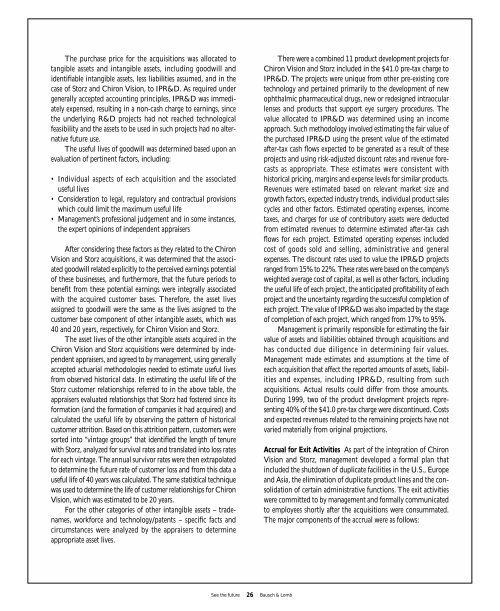Create successful ePaper yourself
Turn your PDF publications into a flip-book with our unique Google optimized e-Paper software.
The purchase price for the acquisitions was allocated to<br />
tangible assets and intangible assets, including goodwill and<br />
identifiable intangible assets, less liabilities assumed, and in the<br />
case of Storz and Chiron Vision, to IPR&D. As required under<br />
generally accepted accounting principles, IPR&D was immediately<br />
expensed, resulting in a non-cash charge to earnings, since<br />
the underlying R&D projects had not reached technological<br />
feasibility and the assets to be used in such projects had no alternative<br />
future use.<br />
The useful lives of goodwill was determined based upon an<br />
evaluation of pertinent factors, including:<br />
• Individual aspects of each acquisition and the associated<br />
useful lives<br />
• Consideration to legal, regulatory and contractual provisions<br />
which could limit the maximum useful life<br />
• Management’s professional judgement and in some instances,<br />
the expert opinions of independent appraisers<br />
After considering these factors as they related to the Chiron<br />
Vision and Storz acquisitions, it was determined that the associated<br />
goodwill related explicitly to the perceived earnings potential<br />
of these businesses, and furthermore, that the future periods to<br />
benefit from these potential earnings were integrally associated<br />
with the acquired customer bases. Therefore, the asset lives<br />
assigned to goodwill were the same as the lives assigned to the<br />
customer base component of other intangible assets, which was<br />
40 and 20 years, respectively, for Chiron Vision and Storz.<br />
The asset lives of the other intangible assets acquired in the<br />
Chiron Vision and Storz acquisitions were determined by independent<br />
appraisers, and agreed to by management, using generally<br />
accepted actuarial methodologies needed to estimate useful lives<br />
from observed historical data. In estimating the useful life of the<br />
Storz customer relationships referred to in the above table, the<br />
appraisers evaluated relationships that Storz had fostered since its<br />
formation (and the formation of companies it had acquired) and<br />
calculated the useful life by observing the pattern of historical<br />
customer attrition. Based on this attrition pattern, customers were<br />
sorted into “vintage groups” that identified the length of tenure<br />
with Storz, analyzed for survival rates and translated into loss rates<br />
for each vintage. The annual survivor rates were then extrapolated<br />
to determine the future rate of customer loss and from this data a<br />
useful life of 40 years was calculated. The same statistical technique<br />
was used to determine the life of customer relationships for Chiron<br />
Vision, which was estimated to be 20 years.<br />
For the other categories of other intangible assets – tradenames,<br />
workforce and technology/patents – specific facts and<br />
circumstances were analyzed by the appraisers to determine<br />
appropriate asset lives.<br />
See the future 26<br />
<strong>Bausch</strong> & <strong>Lomb</strong><br />
There were a combined 11 product development projects for<br />
Chiron Vision and Storz included in the $41.0 pre-tax charge to<br />
IPR&D. The projects were unique from other pre-existing core<br />
technology and pertained primarily to the development of new<br />
ophthalmic pharmaceutical drugs, new or redesigned intraocular<br />
lenses and products that support eye surgery procedures. The<br />
value allocated to IPR&D was determined using an income<br />
approach. Such methodology involved estimating the fair value of<br />
the purchased IPR&D using the present value of the estimated<br />
after-tax cash flows expected to be generated as a result of these<br />
projects and using risk-adjusted discount rates and revenue forecasts<br />
as appropriate. These estimates were consistent with<br />
historical pricing, margins and expense levels for similar products.<br />
Revenues were estimated based on relevant market size and<br />
growth factors, expected industry trends, individual product sales<br />
cycles and other factors. Estimated operating expenses, income<br />
taxes, and charges for use of contributory assets were deducted<br />
from estimated revenues to determine estimated after-tax cash<br />
flows for each project. Estimated operating expenses included<br />
cost of goods sold and selling, administrative and general<br />
expenses. The discount rates used to value the IPR&D projects<br />
ranged from 15% to 22%. These rates were based on the company’s<br />
weighted average cost of capital, as well as other factors, including<br />
the useful life of each project, the anticipated profitability of each<br />
project and the uncertainty regarding the successful completion of<br />
each project. The value of IPR&D was also impacted by the stage<br />
of completion of each project, which ranged from 17% to 95%.<br />
Management is primarily responsible for estimating the fair<br />
value of assets and liabilities obtained through acquisitions and<br />
has conducted due diligence in determining fair values.<br />
Management made estimates and assumptions at the time of<br />
each acquisition that affect the reported amounts of assets, liabilities<br />
and expenses, including IPR&D, resulting from such<br />
acquisitions. Actual results could differ from those amounts.<br />
During <strong>1999</strong>, two of the product development projects representing<br />
40% of the $41.0 pre-tax charge were discontinued. Costs<br />
and expected revenues related to the remaining projects have not<br />
varied materially from original projections.<br />
Accrual for Exit Activities As part of the integration of Chiron<br />
Vision and Storz, management developed a formal plan that<br />
included the shutdown of duplicate facilities in the U.S., Europe<br />
and Asia, the elimination of duplicate product lines and the consolidation<br />
of certain administrative functions. The exit activities<br />
were committed to by management and formally communicated<br />
to employees shortly after the acquisitions were consummated.<br />
The major components of the accrual were as follows:



